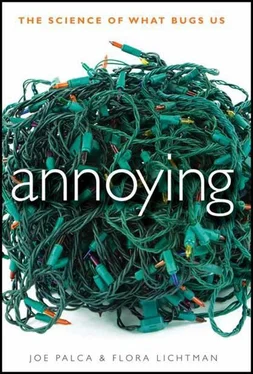“This totally sucks,” Patti thought. “How am I supposed to answer questions in this environment? And why the heck can’t he hear me? He’s either deaf, or this equipment isn’t working. And why am I not seeing any more words?”
“I’m cutting short the experiment,” Denson said after a minute or two had passed. “Before we end, I’m going to project a series of statements on the screen. You don’t have to do anything. Just read the statements and think about them.” He added sarcastically, “Do you think you can do that?”
Patti didn’t say anything, because she was pretty sure Denson wouldn’t want to hear what she really wanted to say to him.
The first statement flashed on the screen: “Think about whom you have interacted with in the experiment up to this point.” About a dozen similar statements followed. Finally, Denson’s voice came back into her ears. “We’re finished now.”
“And not a moment too soon,” thought Patti. “That was totally annoying. I’m never going to sign up for another experiment. Maybe I should change majors.”
The previous story is essentially true, although some of the details were changed, and Patti is a hypothetical composite of the twenty students who participated in the experiment. Thomas Denson is extremely real.
As you may have suspected, this wasn’t an experiment about cognition at all. Basically, a scientist put an unsuspecting subject into a brain scanner and annoyed her to see what happens in her brain. Denson was technically studying anger, but he’s willing to concede the point. “As far as I know, no one has really argued for annoyance as a separate, discrete emotion from anger,” he says. “I would say annoyance is the low level of anger, with rage being on the extreme end.”
Because he has to convince review committees that his research is ethical before he is allowed to carry it out, he admits that he really is only trying to annoy people in his experiments. “We’re not really allowed to make people excessively angry,” says Denson. “But we wanted to do something realistic. Everyone’s had a boss who said, ‘Look, you really screwed this up.’ And that makes you feel stupid. People tend to respond with annoyance to that.”
After the subjects came out of the MRI, they completed something called the Positive and Negative Affect Schedule. It’s a scale that measures how angry/annoyed someone is. Only after the subjects filled out this final questionnaire did Denson tell them what the experiment was really about. There are no published data on whether they were in a forgiving mood after the experiment was over. Denson says there were several factors designed to get the subjects annoyed. First, the anagrams: “A couple of the anagrams were easy. But most were really hard. Words like ‘lieutenant’ and ‘environment.’ Words with lots of vowels. And because we told them this was a test of their cognitive ability,” in other words, how smart they were, “they were really invested in it. They wanted to do well.”
Of course, they didn’t do well, and that alone got the subjects annoyed. Then there was the banging of the MRI. That was a freebie. All MRIs make a version of that annoying banging. “The key part is that at three different points I interrupted them,” says Denson.
The first two times he spoke in a calm voice, asking the subjects to speak up, even though he could hear them perfectly well. The third time, however, Denson tried to sound like he was losing his cool and getting pissed off. “That was all part of the script,” says Denson.
When the subjects were good and annoyed, Denson took another brain image. Denson used a special form of MRI called functional MRI. Instead of using the machine to map structures in the brain, an fMRI measures where blood is flowing in the brain. The more brain cells are active in a particular region, the more blood flows to that region, suggesting that this particular area is implicated in whatever behavior or emotion a researcher is measuring.
In this case Denson measured which brain areas were active when the subjects were lying quietly inside the MRI and compared that with where the blood flowed when they were annoyed. What he found was that an area called the dorsal anterior cingulate cortex was most active at the end of the experiment when his subjects were all riled up. This is a part of the limbic system. The limbic system is in the forebrain. It’s a system of brain regions that seems to be more involved with emotion than with rational thought. In Huntington’s and traumatic brain injury patients, the theory is that their irritability is linked to the inability to regulate their limbic systems because of damage to their frontal lobes.
Denson says that the dorsal anterior cingulate cortex is “a pretty interesting little region, because it’s sort of like the gatekeeper between automatic or unconscious processes and more conscious processes.” Denson agrees with many psychologists who believe that most people go through their days in automatic mode, more or less on autopilot. Consider the experience of driving home from work. You’ve done it a million times. It’s totally routine. You get home, and you suddenly think, “Whoa, what just happened?” You have no specific recollection of the drive home.
Some psychologists call this “autopilot” the x-system. It’s not that you are unconscious as you go through your day, it’s simply that you are not at that heightened level of attention that you would be if you were trying to find your way around in an unfamiliar city. Autopilot doesn’t work in that circumstance, because nothing is routine. You have to pay close attention to everything, or you’ll get lost.
Denson says that the dorsal anterior cingulate cortex switches you from autopilot mode into active attention mode. “So, take the same example,” he says. “You’re driving home, and now suddenly someone cuts you off and then flips you off for good measure. That dorsal anterior cingulate cortex is going to be active. It’s going to wake up and say, ‘Hey, I need some higher brain functions to come on board here and help me solve this problem.’ So, it wakes the brain up.”
This squares well with the explanation of annoyances being like halfalogues: they tend to be a disruption, and their unpredictability puts you in a heightened state of alertness. You can’t tune them out.
Denson believes that’s what happened in his experiment. The subjects came to the lab, like good college sophomores in psychology experiments are supposed to do. They expected to be treated in a certain way, and their minds were most likely focused entirely on other things. “And suddenly I’m treating them like kindergarteners. So the dorsal anterior cingulate cortex gets active.”
Denson also wanted to see whether the subjects who were the angriest by the end of the experiment were also the ones who had the most blood flowing to the dorsal anterior cingulate cortex. That’s what the mood-and-aggression questionnaires were all about. Indeed, he did see a correlation between the level of anger and blood flow to the dorsal anterior cingulate cortex, but this was a small study—only twenty people—so sweeping conclusions are premature.
The limbic system’s role in annoyance is probably a crucial one. Brain responses in the limbic system are only somewhat under our conscious control. You can learn that a particular dark cave doesn’t pose a danger, but you will always feel at least a tingle of apprehension when you enter one. You can learn to control your annoyance with someone or something, but somewhere deep down, the limbic system will still insist that the annoying wail of a baby’s cry is something you want to turn off if you possibly can.
The more “rational” part of the brain is usually associated with the cortex. The word rational is in quotes because numerous authors have shown that people can be counted on to behave irrationally. Maybe a better word is cognitive . It’s the part of the brain that considers the facts at hand, evaluates them, and then makes some decision—rational or not—on how to behave next. In Huntington’s patients, this part of the brain deteriorates, which may partly explain the emotional outbursts.
Читать дальше












